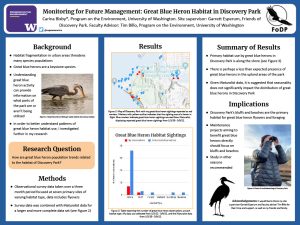Monitoring for Future Management: Great Blue Heron Habitat in Discovery Park
As urban areas continue to expand within the Puget Sound region, pressures on the natural environment become more visible on all ecological levels. In monitoring keystone species such as great blue herons, it is possible to evaluate how organizations such as Friends of Discovery Park (FODP) can manage natural areas to better promote habitat health and population stability. The purpose of this study was to monitor how great blue herons utilize the diverse habitat of Discovery Park, and to evaluate what abiotic and/or biotic trends influence behavior and population dispersal. This was accomplished by collecting observational data of great blue herons revolving around seven main locations across the park. Throughout the course of this internship it was found that a majority of great blue heron sightings were concentrated around the beaches of Discovery Park, with very little population data collected in the upland area of the park. Due to the foraging habits of great blue herons, the lack of presence in the upland area of the park was not an insignificant find. However, future population monitoring or perhaps utilization of citizen science databases is recommended in order to more fully map the use of Discovery Park by great blue herons. In understanding how natural spaces are utilized by keystone species, groups such as FODP are better equipped to meaningfully increase habitat health and availability in the Puget Sound through restoration and management.
